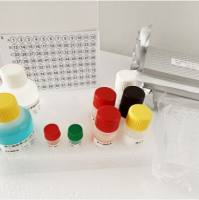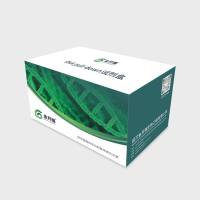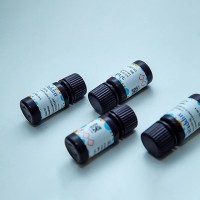|
ABSTRACT |
|
Protein complexes can be digested directly using a number of different protocols. The methods presented here include a double digest with endoproteinase Lys-C and trypsin, or a triple digest with elastase, subtilisin, and trypsin. Endoproteinase Lys-C cleaves carboxy-terminal to lysine residues, while trypsin cleaves carboxy-terminal to lysine and arginine residues. The triple digest uses the relatively nonspecific proteases elastase and subtilisin to create a large number of overlapping peptides for the analysis of posttranslational modifications (MacCoss et al. 2002b). The double and triple digest protocols begin with the reduction and alkylation of cysteine residues to disrupt disulfide bonds and, therefore, higher-order protein structure. |
|
|
|
MATERIALS |
|
Buffers, Solutions, and Reagents
-
Acetone, cold
-
CaCl2 , 1 M
-
Formic acid, 90%
-
Milli-Q water
-
Protein complex of interest in solution
-
Trichloroacetic acid (TCA), 20%
-
Tris (2-carboxyethyl)-phosphine hydrochloride (TCEP), 100 mM
-
Iodoacetamide (IAA), 500 mM, prepare fresh
-
Tris-HCl (or Trizma base), 100 mM (pH 8.0)
-
Urea, 8 M in 100 mM Tris-HCl (pH 8.0)
Enzymes
-
Elastase Grade II
-
Endoproteinase Lys-C
-
Purified complex of interest
-
Subtilisin
-
Trypsin, sequencing grade, modified
Special Equipment
-
Incubator, preset to 37°C
-
Microcentrifuge, precooled to 4°C
|
|
METHOD |
-
Often, one starts this procedure by TCA-precipitating a purified protein complex out of solution. To do this: Add an equal volume of 20% TCA to the protein sample (the protein concentration will vary depending on the experiment); incubate 30 min on ice; centrifuge at 12,000g in a microfuge at 4°C for 15 min; carefully remove all supernatant; add ~300 µl of cold acetone and centrifuge at 12,000g for 5 min at 4°C; remove the supernatant and air-dry the pellet. Redissolve the protein pellet in 8 M urea in 100 mM Tris-HCl (pH 8.0). Typical resuspension volumes are between 50 and 100µl.
Make the urea/Tris solution fresh each time because urea breaks down over time into ammonium cyanate, which can cause carbamylation of the amino termini of peptides as well as lysine and arginine side chains.
-
Add 100 mM TCEP to the protein solution to a final concentration of 5 mM (add ~2.5 µl if the previous volume was 50 µl) and incubate at room temperature for 20-30 min.
-
Add 500 mM freshly made IAA to a final concentration of 10 mM (add 1.0 µl, if the starting volume in step 1 was 50 µl) and incubate for 20-30 min in the dark at room temperature.
Double Digestion
-
Begin digestion by adding endoproteinase Lys-C to a final concentration of 0.002 µg/µl, and incubate at 37°C in the dark for 4 hr.
For complex mixtures of proteins, incubate the samples overnight.
-
Dilute the sample to 2 M urea by adding 100 mM Tris-HCl (pH 8.0) (add 150 µl if starting volume in step 1 was 50 µl). Add 1 M CaCl2 to a final concentration of 2 mM, and trypsin to a final concentration of 0.01 µg/µl. Incubate overnight (12-24 hr) at 37°C.
-
After incubation, quench the digestion by adding 90% formic acid to a final concentration of 5%. Store at -20°C until needed for analysis by ESI MS/MS.
-
Rehydrate the slices by adding 100 µl of 100 mM NH4 HCO3 . Wait 5 min, and then add 100 µl of acetonitrile. Incubate for 15 min at room temperature. If Coomassie staining was used to visualize the proteins and a strong blue color persists, incubate for a further 15 min with continuous gentle vortexing. Remove the liquid and dry down the gel pieces in a speed vacuum for 15 min.
Triple Digestion (Alternative to Double Digestion)
-
Take the IAA-treated sample (from step 3) and divide into three aliquots of equal volume. Each aliquot will be treated with a different protease and then pooled after digestion.
Fraction 1
Dilute fraction 1 to 2 M urea with 100 mM Tris (pH 8.0), add 1 M CaCl2 to a final concentration of 2 mM, and trypsin to a final concentration of 0.01 µg/µl. Incubate overnight (12 hr) at 37°C.
Fraction 2
Dilute fraction 2 to 2 M urea with 100 mM Tris (pH 8.0) and add elastase to a final concentration of 0.005 µg/µl. Incubate for 4 hr at 37°C. Store at -20°C until fraction 1 is ready.
Fraction 3
Dilute fraction 3 to 4 M urea with 100 mM Tris (pH 8.0) and add subtilisin to a final concentration of 0.002 µg/µl. Incubate for 4 hr at 37°C. Store at -20°C until fraction 1 is ready.
-
After digestion, pool the three fractions and quench the reactions by adding 90% formic acid to a final concentration of 5%. Store at -20°C until needed for analysis by ESI MS/MS.
|







